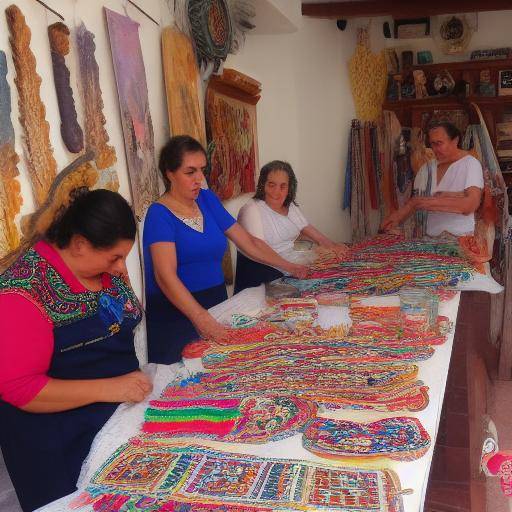
Bali, known as the "Island of the Gods", is more than a paradisiacal tourist destination. This jewel of Indonesia has been the epicenter of a rich artisanal tradition that has endured over the centuries. At the heart of the cultural identity of Bali is its art and crafts, which reflects the very essence of the Balkan people. From craft workshops to the bustling traditional art markets, immerse yourself in the vibrant world of Balinese crafts.
History and craft tradition
Bali has been a kettle of artistic creativity for over a thousand years. Artisanal skills are transmitted from generation to generation, including wood sizes, goldsmiths, textile weaving and ceramics. This tradition has remained alive thanks to the devotion of the Balines to their spiritual beliefs and to the preservation of their cultural heritage.
Origins and historical significance
The origins of art and crafts in Bali go back to the kingdom of Majapahit in the 14th century, which significantly influenced the Balkan culture and art. The arrival of Hinduism in the 15th century and the rich cultural interaction that further shaped local craft practices. Balkan art is not only an aesthetic expression, but also a spiritual expression, with a profound connection to mythology, religion and nature.
Markets and workshops: cultural oasis
The traditional art markets in Bali are real treasures, full of unique and authentic pieces that reflect the island's artistic diversity. From the bustling Ubud market to the picturesque craft villages of Mas and Celuk, every corner of Bali hosts workshops by artists and markets that dazzle with their artisanal talent.
Ubud: artistic epicentre
Ubud, a cultural enclave in the heart of Bali, is famous for its art market and numerous artists' workshops. Here, visitors can lively experience the creation of traditional paintings, sculptures and handicrafts as they wander through their charming streets.
Mas and Celuk: handicraft cribs
The towns of Mas and Celuk are known for their skilled wood sculptors and goldsmiths respectively. Art admirers can witness teachers to create masterpieces with exceptional meticulousness and skill. Local markets offer a wide range of artisanal treasures that capture the very essence of the Balinese tradition.
Balinese crafts: a manifestation of the cultural soul
Balinese crafts are not only decorative objects, but a vivid manifestation of the rich culture and spirituality of the island. Each piece tells a story, either through its intricate designs, cultural symbolism or traditional manufacturing techniques. Diving into the world of Balinese handicrafts is an experience that provides a deeper understanding of the culture and daily life of the Baliness.
Artisanal diversity
The Balinese craftsmanship encompasses a wide range of products, from sculptures of Hindu deities to hand-woven textiles and elaborate jewelry. Each piece is a unique work of art that reflects the artisanal mastery and the unlimited creativity of the Balinese artisans.
Cultural design rooted in tradition
The design of the Balinese handicrafts is not only aesthetically beautiful, but also permeated with cultural and spiritual meaning. The motifs and patterns represent myths, legends and elements of nature, creating a deep connection between Balinese art and cotidianity.
Balinese craftsmanships: a living legacy of Bali identity
Balinese crafts reflect the very essence of the island, capturing the essence of its rich history, its spirituality and its connection to nature. Each piece exhibits deep respect for tradition and crafts, making them treasures appreciated both locally and internationally. From exquisite sculptures to intricate pieces of jewelry, the Balinese handicrafts continue to captivate the admirers of art and culture.
Modern perspective: current trends and challenges
As Bali opens to the modern world, traditional crafts face challenges and opportunities. Industrialization and globalization pose challenges in the preservation and promotion of Balinese art and crafts. However, local craftsmen and designers are adapting traditional techniques to create contemporary designs that align with current trends.
Sustainability and preservation
The growing awareness of sustainability and cultural heritage has led to renewed interest in Balinese crafts. Efforts to preserve traditional techniques and promote sustainable artisanal practices are critical to ensuring the continuity and relevance of these forms of art in the future.
Innovation and creativity
The Brazilian craftsmen and designers explore new forms of expression by keeping traditions alive. The combination of traditional techniques with innovative materials and contemporary designs has resulted in a unique fusion that attracts a diverse audience, both local and international.
The global impact of Balinese art and crafts
Balinese handicrafts have transcended borders, gaining recognition in international markets and the global scene of design. Their authenticity and singularity have turned them into objects of desire for collectors and art lovers. Collaboration with international designers and their presence on e-commerce platforms have further expanded their global reach and appreciation.
Revaluation of traditional art
Interest in traditional art and crafts is experiencing rebirth around the world. Balinese handicrafts have become symbols of authenticity, expert craftsmanship and connection to culture, attracting a new generation of art enthusiasts and collectors.
Contribution to global cultural identity
Balinese art and crafts have played a crucial role in the projection of Bali's cultural identity worldwide. These masterpieces have transcended geographical and cultural boundaries, serving as cultural ambassadors who convey the essence and beauty of Bali to the world.
Conclusions and final reflections
Bali and its traditional art and crafts are a cultural treasure that deserves to be admired and appreciated. The deep connection between art and daily life in Bali reveals a rich history and a living tradition that continues to inspire generations. By exploring traditional craft workshops and art markets, one not only acquires unique pieces, but dives into a world full of cultural meaning and spirituality.
FAQs
What are some of the most common materials used in Balinese crafts?
Balinese crafts typically use natural materials such as wood, stone, metals, and fabrics such as cotton and bamboo. These materials are carefully selected to ensure the authenticity and durability of the pieces.
What is the importance of Balinese handicrafts in local society?
Balinese crafts are an integral part of everyday life and have a profound meaning in local society. They not only provide sustenance to artisans, but also play an important role in religious rituals and traditional festivities.
#### What are some of the most outstanding workshops in Bali to witness the creation of live handicrafts?
Bali hosts numerous workshops where visitors can see artisans work in their creations. Some of the highlights are the wood sculpture workshops in Mas, the goldsmith workshops in Celuk, and the painting workshops in Ubud.
How have Balinese crafts adapted to modern trends?
The Balinese artisans have integrated traditional techniques with contemporary designs and innovative materials to adapt to current trends. This has allowed them to maintain the relevance of their creations in the global market.
What is the economic impact of Balinese handicrafts on the island?
Crafts is a vital part of the Bali economy, providing employment and income to many local households. In addition, tourism related to art and crafts also contributes significantly to the island's economy.
How can we support the preservation of traditional art and crafts in Bali?
Visitors can support the preservation of Balinese art and crafts by directly purchasing local artisans and being aware of the authenticity and value of the pieces they acquire. Local organizations can also be found to work on the preservation of traditional artisanal practices.
What are some recommendations for travelers interested in exploring Balinese art and crafts?
For travelers interested in Balinese art and crafts, it is recommended to visit local markets, participate in artisan workshops and take into account the importance of being respectful and aware of the authenticity of the purchased pieces.
We hope that these answers will provide a deeper understanding of the impressive world of Balinese crafts and inspire readers to explore and appreciate this rich artistic tradition during their visits to Bali.
In conclusion, the Balinese handicrafts are a living testimony of the island's cultural identity, capturing the essence of its rich history, its spirituality and its connection to nature. Each piece reflects deep respect for tradition and crafts, making them treasures appreciated both locally and internationally. By exploring artists' workshops and traditional art markets, one not only acquires unique pieces, but dives into a world full of cultural meaning and spirituality that continues to resonate over the centuries.
Love yourself with the Balinese crafts, discover your story, immerse yourself in your creativity and bring home a piece of the soul of Bali.





